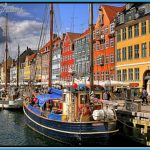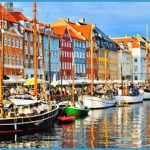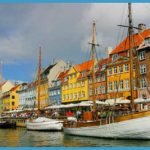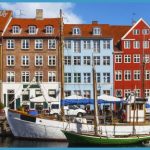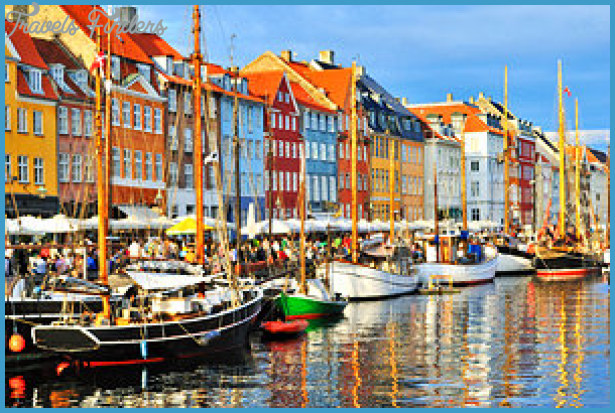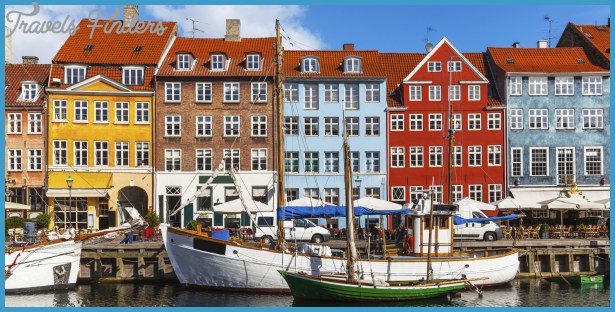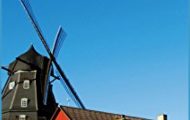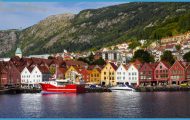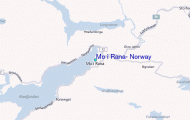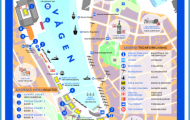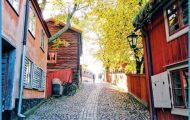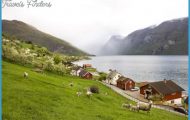From Town Hall Square the pedestrian precinct known as Stroget, a succession of short streets running into one another, extends E to Kongens Nytorv, lined by shops, boutiques and street cafes. A little way E of Town Hall Square the street opens out to form two squares, Gammel Torv and Nytorv. In Nytorv are old patrician houses dating from about 1800. Farther along Stroget, on the left, is the Church of the Holy Ghost (Hel-ligandskirken), with the Helligandshus, the only medieval building in Copenhagen, originally belonging to a monastery. In Amager Torv (No. 6) is what is believed to be the oldest private house in the city, built by Burgomaster Hansen in 1616 (Dutch Baroque style, with a fine
The Exchange, Copenhagen sandstone doorway), and now occupied by the showroom and shop of the Royal Porcelain Manufactory. At No. 10 is lllums Bolighus, a large department store selling fine Danish craft goods. After passing the Stork Fountain we come into Kongens Nytorv, a large square (3-3 hectares 8i acres) laid out towards the end of the 17th c„ with an equestrian statue of Christian V in the middle. On the S side of the square is the Theatre Royal (Kongelige Teater, 1872-4), in late Renaissance style. In front of the entrance are bronze statues of the Danish dramatists Ludwig Holberg (author of comedies) and Adam Oehlenschlager (tragedies).
On the E side of Kongens Nytorv stands Charlottenborg Palace, since 1754 occupied by the Royal Academy of Art. Beyond the palace can be seen Nyhavn (New Harbour), flanked by old-world gabled houses. At the upper end is a gigantic anchor, commemorating Danish seamen who lost their lives in the last war. Nyhavn, from which boats leave for tours of the city, was once a disreputable quarter of the city: it is now a very charming part of Copenhagen, with its numerous brightly coloured little houses on the left-hand side of the canal and its restaurants, bars and tattooists’ parlours. From Nyhavn there is a hydrofoil service to Malmo in Sweden (35 minutes) and also boat cruises on the canals. At the upper end of Nyhavn is Bredgade. Going along this street, we pass a number of old mansions and come to the Marble Church (Marmorkirken, Frederikskir-ken), begun in 1749 but not completed until 1 894 because of shortage of funds. The church has a dome 84 m (275 ft) high, and the facade is decorated with statues of great figures in Biblical and ecclesiastical history, including St Ans-gar, the Apostle of the North, and Bishop Grundtvig, the 1 9th c. religious reformer. Features in the interior include an ivory crucifix, a German carving in oak of the Descent from the Cross and Grundtvig’s seven-branched gold candelabrum. Frederiksgade, opposite the church, leads to Amlienborg Palace, residence of the Queen. The spacious octagonal.
Copenhagen Travel Photo Gallery
Palace Square is surrounded by the four wings of the palace, originally separate noble mansions. In the middle of the square is an equestrian statue of Frederik V (1771). On the SE side of the square stands the palace of Christian IX, now the home of the royal family (with state apartments); adjoining it is the palace of Frederik VIII, now occupied by Queen Ingrid the Queen Mother; beyond this is the’palace of Christian VIII (Crown Prince Knud); and on the SWside ofthe square is the palace of Christian VII, with the main state apartments and reception rooms. The ceremonial changing of the guard takes place daily at noon in front of the palace, with a military band when the Queen is present. The soldiers of the royal guard, with their blue uniforms and tall black fur caps, are one of the familiar sights of Copenhagen.
Returning to Bredgade, we continue past the Russian Alexander Nevsky Church, with three gilded onion domes, and the District Court, originally the Opera House, which laterserved as a military academy, a barracks, and from 1 884 to 1 91 8 (afterthe destruction of Christiansborg by fire) as the home of the Danish Parliament. On the opposite side of the street is St Ansgar’s Church, Copenhagen’s oldest Roman Catholic church and, since 1 942, of cathedral status (fine statue of St Ansgar on fapade). Adjoining the church is the Museum of Applied Art (Kunst-industrimuseet), with international collections of applied and decorative art of the past and present (notable 1 6th and 17th c. wood-carving). Bredgade now joins Esplanaden, along which to the right is the old citadel, Kastellet. Before visiting this it is well worth while going a short
The Little Mermaid, Copenhagen distance along the street to the left to see Nyboder, a settlement of characteristic old 17th and 18th c. houses low yellow terraced houses in uniform style built to accommodate sailors of the Danish fleet. The 17th c. houses at 20-40 Skt. Pauls Gade are the oldest.

